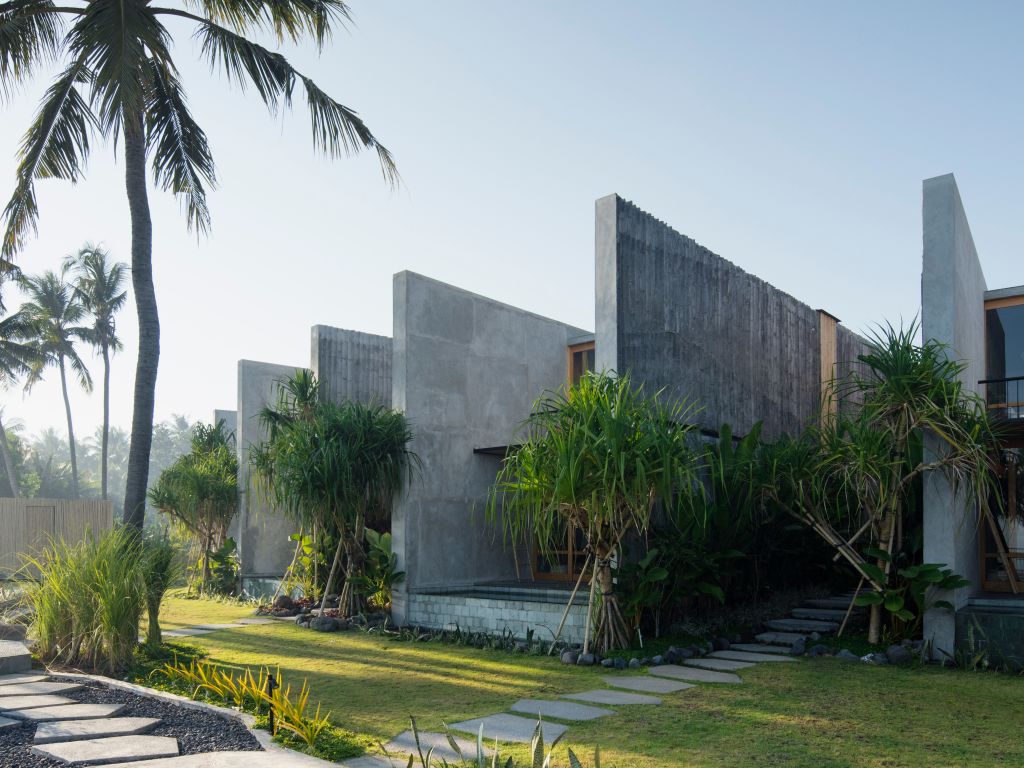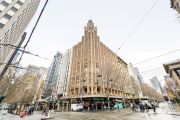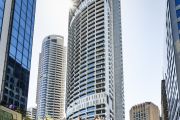
Australian-designed Bali resort The Tiing in line for major design award
Its honeymoon phase was cut sharply short by the COVID-19 pandemic, but a lack of visitors hasn’t stopped The Tiing resort, opened in 2019 and located on Bali’s north coast, from receiving plaudits from the design community.
With a name that means “bamboo”, The Tiing’s short life-cycle mirrors the impact of the COVID-19 pandemic on one of the world’s favourite tourist destinations.
Designed by Perth architect Nic Brunsdon and with only 14 suites housed in seven concrete-bladed pavilions that look to both mountain and sea, The Tiing opened in March 2019 and was going gangbusters for 12 months until “the island of the gods” started to close its doors to the outside visitors who fuel 60 to 80 per cent of its economy.
Suddenly, a refined but minimally appointed new resort, with a design which was justifiably celebrated by being shortlisted in 2019’s World Architecture Festival, became just another near-empty venue on an island that in that same year attracted 6.3 million visitors to fill its 130,000 available hotel rooms.
Within two months of the border being sealed, tourism authorities estimated that 93 per cent of visitors had disappeared from a tropical paradise that had hitherto been nudging New Zealand off the podium as the most favoured offshore destination for Australians.
The Tiing, Brunsdon told Commercial Real Estate, is currently ticking over by charging bargain basement rates – less than half the usual prices – to the handful of international expats who, for one reason or another, “are orphans still stuck on the island”.
Nice place to be stuck. And with Bali announcing it will remain closed until at least 2021, sweet tariffs to be paying for the privilege of enjoying a place that hasn’t been so low-key since the 1970s.
The facility, which advertises itself as a reward for intrepid travellers because it is located three hours from Denpasar over bad roads, had been proving hugely popular with eastern European, French and German holidaymakers.
Brunsdon is optimistic, however, that the “sensitive” resort he designed along with local architect Parisuda Mangun of Architecture Manguning, will rise again.
“It’s only half-open now but I’ve heard that future bookings are going really well.”
Again on the radar as a praise-worthy architectural exercise, Brunsdon’s conception for such a culturally-responsive Balinese resort has made it through to the shortlist of the third annual Dezeen Awards, which has culled 4300 international submissions to showcase what it considers the greatest of the recently finished buildings, interiors, landscapes and furnishings.
In the 42 categories, and of the 187 potential finalists sorted out by one of the globe’s leading online architectural journals, Australia has 13 entries in architecture and interiors.
Andrew Burges’ Bondi Bismark House has warranted three entries. But some of the other Australian names to look out for – and vote for in the People’s Choice category – include John Wardle, Edition Office, CplusC, David Boyle, Durbach Block Jaggers and James Garvan, whose residential contender is also in Bondi.
The Tiing, which was leading the People’s Choice category for hospitality buildings at the time of publishing, is one of the two offshore entries made by Australian studios that are in the running for the main awards to be announced at the end of November, joining Koning Eizenberg’s very interesting arrested decay redevelopment of a children’s museum in a lightening-hit building in Pittsburg in the US.
In an ordinary year The Tiing would be thriving. But right now, the passing of time will mellow the strong concrete bladed-structure of the seven, two-level “funnel” structures that fan subtly across the site and direct the eye outward, either to the sea in one direction or to jungle-covered mountains in the other.
“It’s about seeing both at the same time,” said the architect. “You can lie in bed and turn your head one way to see the ocean, the other and see the mountain”.
Brunsdon said the developer could have doubled the resort’s capacity. “But this great client understood the need to be soft and careful about the site. We didn’t want visitors to be packed in like fish.
“The building needed to be generous and soft and gracious because it is next door to a traditional fishing village and we wanted the village life to continue to be played out on the beach in front [of the resort].”
Soft is a curious word to use in association with a development so overtly made of solid concrete and that has eight-metre high walls dividing rooms from open-air side walkways lushly planted with greenery.
A fascinating detail about The Tiing is the textural appearance of alternating faces of the concrete walling. Inspired by the local way of construction, Brunsdon used braced bamboo screens as the formwork for the concrete pours.
When removed, the screens left a negative, fluted impression with the ruggedness the architect was after. “In the cool and beautiful valleys between the villas,” he said, these variably vertical etchings would gain a patina that would just get more interesting over time.
And time, in such a strange state of suspension, is what the island is currently experiencing in abundance.










